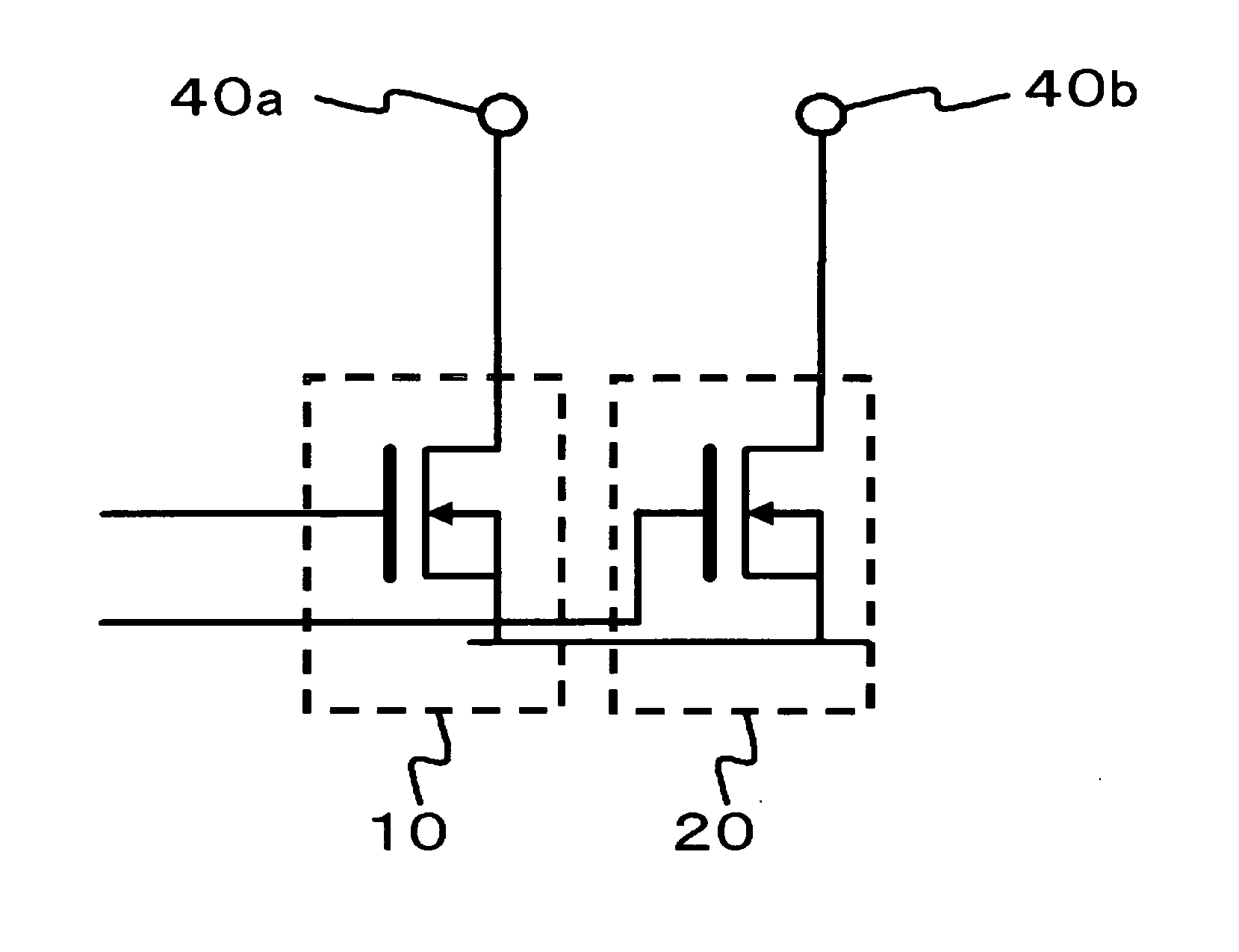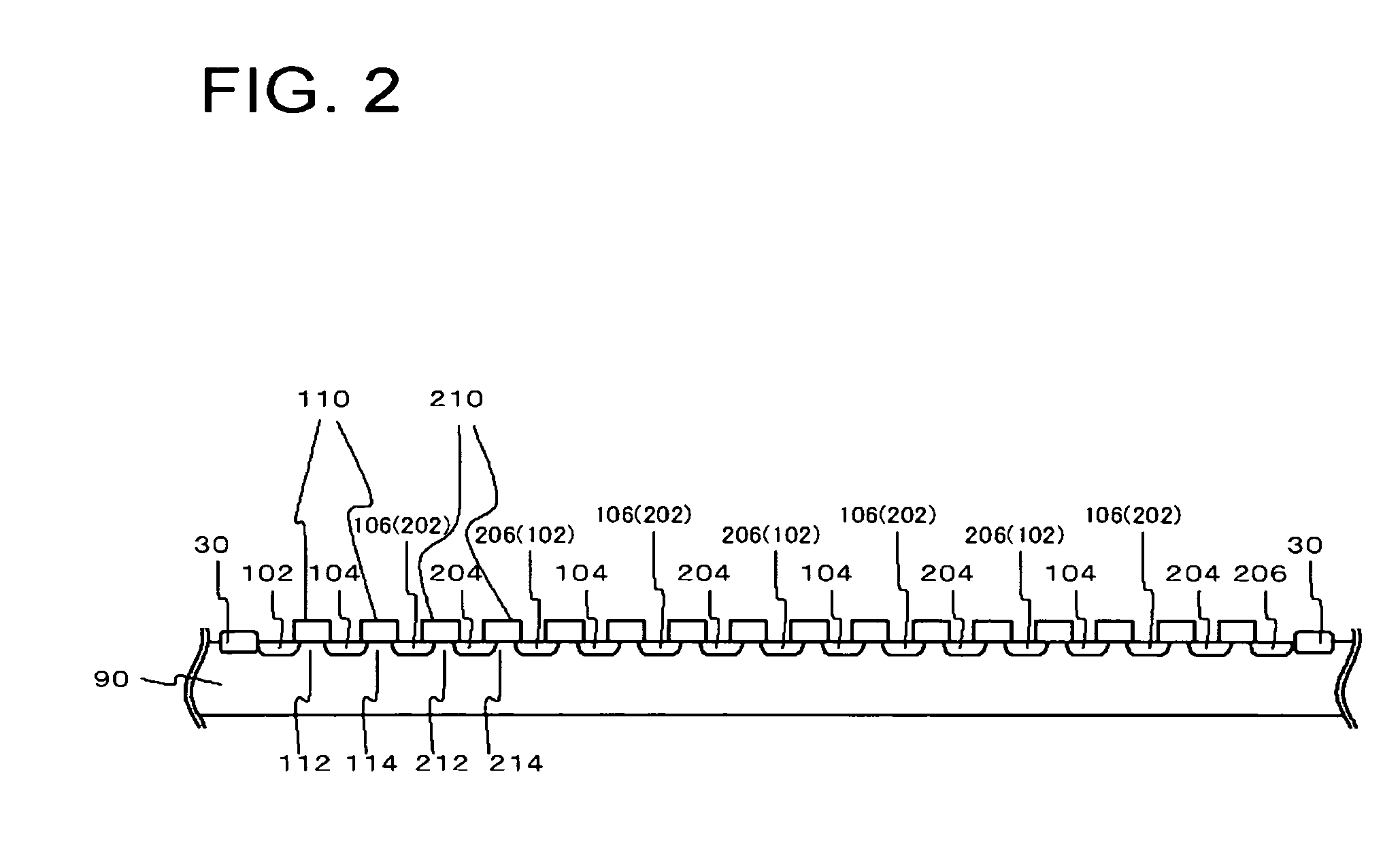Semiconductor device
a technology of semiconductors and transistors, applied in the direction of logic circuits, logic circuit coupling/interface arrangements, pulse techniques, etc., can solve the problems of low peak temperature of each transistor, and achieve the effect of reducing current density, reducing the peak temperature of each transistor, and extensive area
- Summary
- Abstract
- Description
- Claims
- Application Information
AI Technical Summary
Benefits of technology
Problems solved by technology
Method used
Image
Examples
first embodiment
[0023]FIG. 1 is a plan view showing a semiconductor device according to the first embodiment of the present invention. FIG. 2 is a cross-sectional view taken along the line II-II of FIG. 1. The semiconductor device 1 includes transistors 10, 20.
[0024] In this embodiment, the semiconductor device 1 includes a plurality (in this case, four each) of transistors 10, 20. The transistors 10, 20 are alternately aligned in a transverse direction according to the orientation of FIG. 1. Also, as is apparent from FIG. 2, the transistors 10, 20 are located in a device-forming region surrounded by an isolation region 30 formed in a semiconductor substrate 90. Accordingly, the transistors 10 and the transistors 20 are continuously disposed in the semiconductor device 1, without being isolated by the isolation region 30. The semiconductor substrate 90 may be a silicon substrate, for example. The isolation region 30 may be a LOCOS region.
[0025] Each of the transistors 10 (first transistor) is a M...
second embodiment
[0042]FIG. 6 is a plan view showing a semiconductor device according to the second embodiment of the present invention. FIG. 7 is a cross-sectional view taken along the line VII-VII of FIG. 6. The semiconductor device 2 includes transistors 10, 20, drain interconnects 52, 54, and source interconnects 56, 58. The structure of the transistors 10, 20 is similar to that in the semiconductor device 1. In the semiconductor device 2 also, a plurality of the respective transistors 10, 20 is alternately aligned, as in the semiconductor device 1.
[0043] The drain interconnects 52, 54 and the source interconnects 56, 58 are disposed so as to extend along the alignment direction of the transistors 10, 20. These interconnects are disposed in the sequence of the source interconnect 56, the drain interconnect 52, the drain interconnect 54 and the source interconnect 58, in a direction generally orthogonal to the alignment direction. In other words, adjacent to the drain interconnect 52, the drain ...
third embodiment
[0049]FIG. 8 is a plan view showing a semiconductor device according to the third embodiment of the present invention. The semiconductor device 3 includes a plurality (in this embodiment, two) of transistor groups 70a, 70b. The structure of the transistor groups 70a, 70b is similar to that described based on FIG. 1. The transistor groups 70a, 70b are aligned in a vertical direction according to the orientation of FIG. 8. Accordingly, the transistor groups 70a, 70b are aligned generally orthogonally to the alignment direction of the transistors 10, 20 in the transistor groups 70a, 70b. The transistor group 70a and the transistor group 70b are respectively located in different device-forming regions. Therefore, the transistor group 70a and 70b are isolated from each other by the isolation region 30.
[0050] Each gate electrode of the transistor groups 70a, 70b is independently controlled from one another. More specifically, the gate electrode 110 of the transistor group 70a (first tran...
PUM
 Login to View More
Login to View More Abstract
Description
Claims
Application Information
 Login to View More
Login to View More - R&D
- Intellectual Property
- Life Sciences
- Materials
- Tech Scout
- Unparalleled Data Quality
- Higher Quality Content
- 60% Fewer Hallucinations
Browse by: Latest US Patents, China's latest patents, Technical Efficacy Thesaurus, Application Domain, Technology Topic, Popular Technical Reports.
© 2025 PatSnap. All rights reserved.Legal|Privacy policy|Modern Slavery Act Transparency Statement|Sitemap|About US| Contact US: help@patsnap.com



